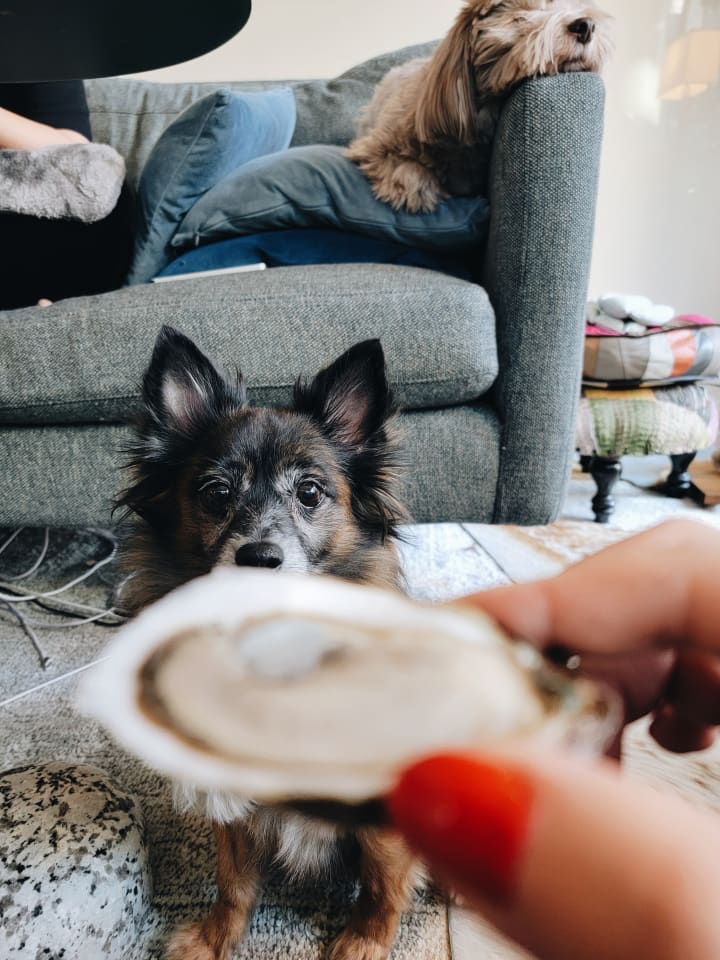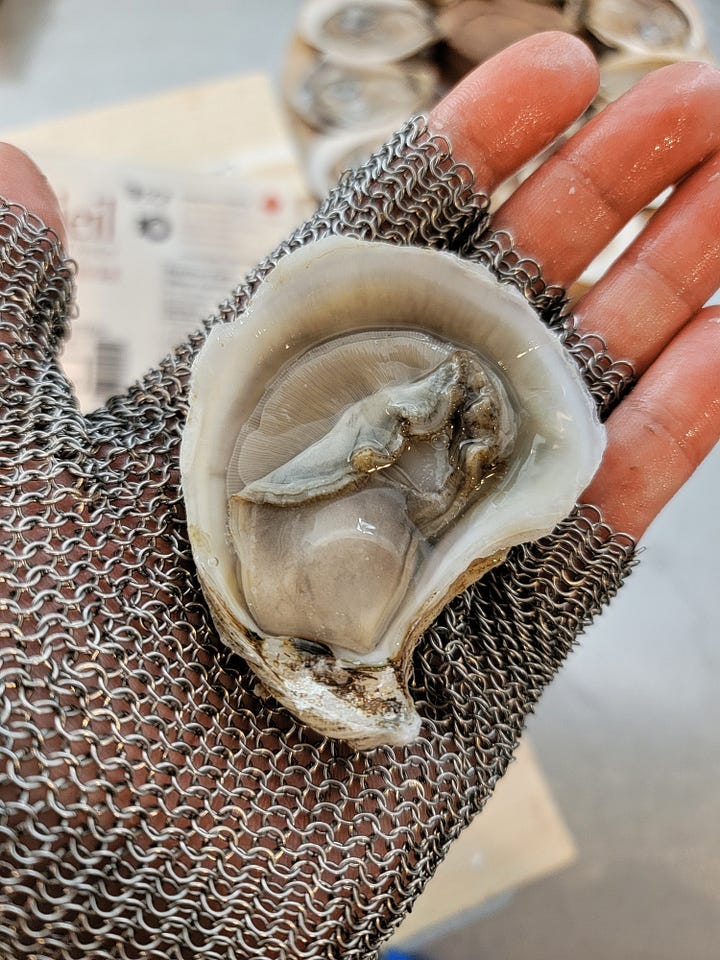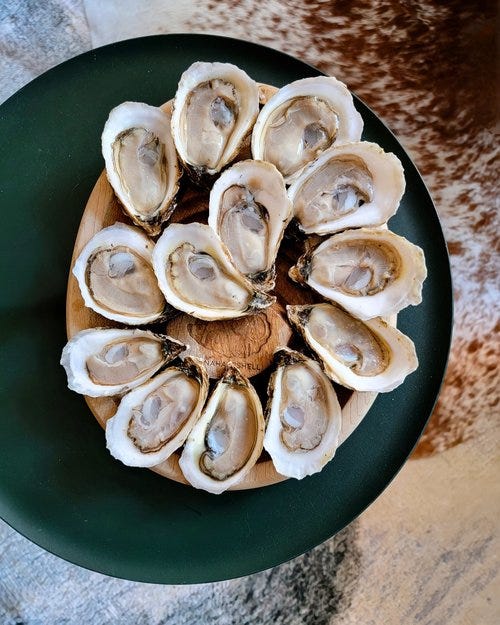Consistency is a prized trait in the oyster world, and New Brunswick has long delivered on that front.
With its cold, pristine waters and skilled growers, the province produces some of the most dependable oysters around. Recently, I revisited two of its most celebrated varieties: BeauSoleil from Miramichi Bay by La Maison BeauSoleil and Belle du Jour from Bouctouche Bay by The Great Little Harbour Seafood Company, thanks to New Brunswick Deliciously Canada.
A Memorable Tasting Experience
My most recent tasting took place in the cozy confines of my friend’s apartment in Chelsea. I was in the thick of organizing the inaugural Oyster Educators Summit, and amidst the hustle, these oysters provided a much-needed culinary interlude. Over several days, Chavelli and I indulged in their briny goodness, sharing moments of joy not just among ourselves but with her adorable doggos as well. To our amusement, Cooper, a dashing Pom-Papillon mix, displayed an unexpected enthusiasm for the oysters, while Bunsen, her cautious Havanese, remained completely indifferent.




I’ve enjoyed New Brunswick oysters for years but rarely written about them in depth. Events like the All-Canadian Oyster Festival in NYC have deepened my appreciation for them. This tasting was the perfect excuse to finally put my thoughts on paper.
First Impressions
Appearance
The BeauSoleils I received had cream-colored shells, a departure from their usual brown, rusty dusting. Belle du Jour oysters, in contrast, had the more familiar brownish tint on the exterior and striking white interiors. A few BeauSoleils possessed “beauty queen” shells—perfectly teardrop-shaped, deep cups. This level of shell refinement is common among floating tray-cultured New Brunswick oysters, a method innovated and commercialized in Bouctouche Bay. Unlike neighboring Prince Edward Island, where wild bottom-grown oysters still represent a significant part of the industry, New Brunswick growers largely use floating culture to impose more control over the final product.
Shucking & Meat Quality
Shucking was a breeze thanks to their hard shells and well-formed hinges. The cold waters of the Gulf of St. Lawrence slow oyster growth, requiring at least three years to reach cocktail size.
One noticeable feature this time? A striking smoke-to-flint ombré shading on some of the BeauSoleil mantles. I reached out to Amédée Savoie, General Manager of Maison BeauSoleil, to inquire what might cause this unique coloration and he hypothesized, “It’s mostly part of what they eat; we have seen some with red phytoplankton.” He also noted that this isn’t a seasonal occurrence. Variations in flavor and color depend on several things: different production areas, food type of availability, genetics, amongst others, so it can be challenging to pinpoint a single factor. That said, I’m always excited to find new visual expressions of familiar oysters.


Tasting Notes & Merroir
BeauSoleils had moderate salinity, a springy texture, and a delicious seafood-umami quality that ended with a moderately long finish. Miramichi Bay benefits from several rivers feeding nutrient-rich waters into its open, tidal structure. This constant movement fosters well-developed, flavor-rich oysters that have an irresistible “delish shellfish” quality to them.
Bouctouche Bay, in contrast, is more sheltered, with an 11 km sandy barrier dune protecting it from open ocean conditions. It receives significant freshwater inflows from the Bouctouche River and surrounding agricultural areas. This results in oysters with a silkier texture and a slightly milder salinity profile.
Pierre Nadeau of Great Little Harbour noted an interesting seasonal distinction: “We find that during the winter months, the fat stores sweeten the oyster, thus counteracting the ‘salt taste’ in the flesh.” I definitely noticed this effect in the Belle du Jours—initially briny but mellowing quickly. Their meat had a softer texture and a subtle lactic note, offering an interesting contrast to the firmer, umami-rich BeauSoleils.
While both bays contribute to the quality of New Brunswick oysters, their distinct growing conditions create subtle differences in salinity, flavor, and texture. If you want a little more insight into the local oyster culture, check out this fantastic video about oyster farming in New Brunswick with Chef Dennis Prescott!
Shelf Life & Storage
One of the standout qualities of New Brunswick oysters is their incredible shelf life. Thanks to their pristine, hard shells and careful packing, they can last in the refrigerator for days—if not weeks—on end without losing quality. The wooden retail boxes they’re packed in help regulate humidity, keeping them in prime condition for longer.
During the winter months, these oysters are also wet stored before heading to market. In this process, oysters are placed in temperature-controlled, circulating seawater tanks to ensure they remain in peak condition before shipment. Wet storage also helps growers manage inventory more efficiently, allowing them to keep their product available for a longer period when natural harvesting conditions may be limited—though many producers still manage to harvest under ice!
Final Thoughts
Revisiting these New Brunswick oysters reaffirmed my appreciation for their consistency, quality, and pleasing flavor. It also reignited my curiosity to visit the farms and experience firsthand the craftsmanship behind them—hopefully I will get to one day!
For those seeking oysters that are easy to open, reliable, yet full of character, BeauSoleil and Belle du Jour are excellent choices. Their balanced profiles make them perfect for newcomers while offering enough complexity to satisfy seasoned oyster aficionados.
This post was sponsored by New Brunswick Deliciously Canada, but all reflections and opinions are my own. Thank you for your support of my Bivalve Curious work!






